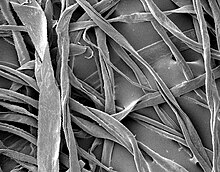
Cotton maturity is a physical testing parameter of cotton fiber properties testing. It is quantified by the degree of cell wall thickening relative to its perimeter. The maturity of individual cotton fiber is an essential aspect of the cotton classing regarding the aesthetics such as appearance, dye-uptake, etc. High volume instrument (HVI) can test cotton maturity like many other fiber properties, including length, uniformity, micronaire/fineness, strength, color, etc.
Major impact
Cotton maturity of fibers largely depends upon the growing conditions. Cotton maturity is measured as the relative wall thickness (i.e., the area of the cell wall to that of a circle with the same perimeter as the fiber, or the ratio of the cell wall thickness to the overall ‘diameter’ of the fiber). Hence the thickness of the wall infers the extent of the maturity of cotton fibers. Cotton fibers are trichome cells composed primarily of cellulose. Mature fibers have more cellulose and a greater degree of cell wall thickening. The significant impact of immature fiber is on the finished appearance. The MIC values of immature fibers determine the processing and performance of cotton. The commonly caused defects by immature cotton are related to yarn and fabric appearance such as poor dyeing uptake, dead fibers, neps formation, and barre also (if the batch to batch maturity ratio is different).
Measurements
Cotton classification, or classing, is the process of classifying cotton based on its grade, staple length, and micronaire. Micronaire is a measure of cotton maturity. Maturity of cotton fibers is measured with single fiber measurement test or by double compression air flow test. It is expressed in percentage or maturity ratio.
Micronaire
Cotton's simple Micronaire value is determined by both the fineness of the fibres as well as their maturity. Micronaire values or reading represents the fineness of the cotton fiber. For example a preferred micronaire range is 3.7 to 4.2. Upland cotton is coarser than Gossypium barbadense (Pima cotton).
See also
References
- "Cotton - Quality". 2007-02-14. Archived from the original on 2007-02-14. Retrieved 2021-01-14.
- Gwathmey, C. Owen; Bange, Michael P.; Brodrick, Rose (2016-05-01). "Cotton crop maturity: A compendium of measures and predictors". Field Crops Research. 191: 41–53. doi:10.1016/j.fcr.2016.01.002. ISSN 0378-4290.
- "2.2.2-Cotton Value Addition-Maturity". www.cottonguide.org. Retrieved 2021-01-14.
- Service, United States Agricultural Research (1944). Research Achievement Sheet. p. 127.
- "The Classification of Cotton". 2011-01-14. Archived from the original on 2011-01-14. Retrieved 2021-01-14.
- Wilmeth, Jo Brice (1953). Cotton Handling Guide for Warehouse Managers and Foremen. U.S. Department of Agriculture, Production and Marketing Administration, Marketing and Facilities Research Branch.
- Glade, Edward H.; Service, United States Dept of Agriculture Economic Research (1981). Cotton Quality Evaluation: Testing Methods and Use. Economic Research Service, U.S. Department of Agriculture. p. 22.
- Brewster, John Monroe (1954). Comparative Economies of Different Types of Cotton-seed Oil Mills and Their Effects on Oil Supplies, Prices, and Returns to Growers. U.S. Department of Agriculture, Agricultural Marketing Service, Marketing Research Division.
- KIM, Hee Jin; LIU, Yongliang; FANG, David D.; DELHOM, Christopher D. (2019-07-04). "Feasibility assessment of phenotyping cotton fiber maturity using infrared spectroscopy and algorithms for genotyping analyses". Journal of Cotton Research. 2 (1): 8. doi:10.1186/s42397-019-0027-0. ISSN 2523-3254. S2CID 197402986.
- "2.2.1-Cotton Value Addition-Micronaire". www.cottonguide.org. Retrieved 2021-01-14.
- ^ Centre, International Trade (2007-12-31). Cotton Exporter's Guide. United Nations. ISBN 978-92-1-361490-7.
- Ahmad, Shakeel; Hasanuzzaman, Mirza (2020-03-05). Cotton Production and Uses: Agronomy, Crop Protection, and Postharvest Technologies. Springer Nature. p. 405. ISBN 978-981-15-1472-2.
- Bunsell, A. R. (2018-01-02). Handbook of Properties of Textile and Technical Fibres. Woodhead Publishing. p. 225. ISBN 978-0-08-101886-6.
- "Cotton Properties". www.cottoninc.com. Retrieved 2022-04-07.
- "2.2.1-Cotton Value Addition-Micronaire". www.cottonguide.org. Retrieved 2022-04-07.
- "Micronaire - an overview | ScienceDirect Topics". www.sciencedirect.com. Retrieved 2021-08-29.
- Fang, David D.; Percy, Richard G. (2020-01-22). Cotton. John Wiley & Sons. p. 708. ISBN 978-0-89118-625-0.